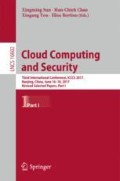Abstract
This work proposed an activity recognition model which focus on the power consuming activity in home environment, to help residents modify their behavior. We set the IoT system with lower number of sensors. The key data for identifying activity comes from widely used smart sockets. It first took residents’ acceptability into consideration to set the IoT system, then used a seamless indoor position system to get residents’ position to help recognize the undergoing activities. Based on ontology, it made use of domain knowledge in daily activity and built an activity ontology. The system took real home situation into consideration and make full use of both electric and electronic appliances’ data into the context awareness. The knowledge helps improve the performance of the data-driven method. The experiment shows the system can recognize the common activities with a high accuracy and have a good applicability to real home scenario.
Access this chapter
Tax calculation will be finalised at checkout
Purchases are for personal use only
References
Sarah, D.: The effectiveness of feedback on energy consumption. In: A Review for DEFRA of the Literature on Metering, Billing and Direct Displays, vol. 486 (2006)
Chen, C., Das, B., Cook, D.J.: A data mining framework for activity recognition in smart environments. In: The 6th International Conference on Intelligent Environments, pp. 80–83 (2010)
Poppe, R.: A survey on vision-based human action recognition. Image Vision Comput. 28(6), 976–990 (2010)
Nappi, M., Piuri, V., Tan, T., Zhang, D.: Introduction to the special section on biometric systems and applications. IEEE Trans. Syst. Man Cybern. Syst. 44(11), 1457–1460 (2014)
Peetoom, K.K.B., Lexis, M.A.S., Joore, M., Dirksen, C.D., De Witte, L.P.: Literature review on monitoring technologies and their outcomes in independently living elderly people. Disab. Rehabil. Assist. Technol. 10(4), 271–294 (2015)
Liu, Q., Cai, W., Shen, J., Fu, Z., Liu, X., Linge, N.: A speculative approach to spatial-temporal efficiency with multi-objective optimization in a heterogeneous cloud environment. Secur. Commun. Netw. 9(17), 4002–4012 (2016)
Wilson, D.H., Atkeson, C.: Simultaneous tracking and activity recognition (STAR) using many anonymous, binary sensors. In: Gellersen, H.W., Want, R., Schmidt, A. (eds.) Pervasive 2005. LNCS, vol. 3468, pp. 62–79. Springer, Heidelberg (2005). doi:10.1007/11428572_5
Tapia, E.M., Intille, S.S., Larson, K.: Activity recognition in the home using simple and ubiquitous sensors. In: Ferscha, A., Mattern, F. (eds.) Pervasive 2004. LNCS, vol. 3001, pp. 158–175. Springer, Heidelberg (2004). doi:10.1007/978-3-540-24646-6_10
Fu, Z., Huang, F., Sun, X., Vasilakos, A.V., Yang, C.-N.: Enabling semantic search based on conceptual graphs over encrypted outsourced data. IEEE Trans. Serv. Comput. (2016)
Shoaib, M., Bosch, S., Scholten, H., Havinga, P.J.M., Incel, O.D.: Towards detection of bad habits by fusing smartphone and smartwatch sensors. In: IEEE International Conference on Pervasive Computing and Communication Workshops (PerCom Workshops), pp. 591–596 (2015)
De, D., Bharti, P., Das, S.K., Chellappan, S.: Multimodal wearable sensing for fine-grained activity recognition in healthcare. IEEE Internet Comput. 19, 26–35 (2015)
Xia, Z., Wang, X., Sun, X., Wang, B.: Steganalysis of least significant bit matching using multi-order differences. Secur. Commun. Netw. 7(8), 1283–1291 (2014)
Abbate, S.: A smartphone-based fall detection system. Pervasive Mob. Comput. 8(6), 883–899 (2012)
Kwapisz, J.R., Weiss, G.M., Moore, S.A.: Activity recognition using cell phone accelerometers. ACM SIGKDD Explor. Newslett. 12(2), 74–82 (2010)
Zhang, Y., Sun, X., Baowei, W.: Efficient algorithm for K-barrier coverage based on integer linear programming. China Commun. 13(7), 16–23 (2016)
Chen, M.: Towards smart city: M2M communications with software agent intelligence. Multimedia Tools Appl. 67, 167–178 (2012)
Pu, Q., Gupta, S., Gollakota, S., Patel, S.: Whole-home gesture recognition using wireless signals. In: Proceedings of the ACM MOBICOM, pp. 27–38 (2013)
Adib, F., Katabi, D.: See through walls with WiFi!. In: Proceedings of the ACM SIGCOMM, pp. 75–86 (2013)
Lai, C.F., Lai, Y.X., Yang, L.T., Chao, H.C.: Integration of IoT energy management system with appliance and activity recognition. In: IEEE International Conference on Green Computing and Communications, pp. 66– 71 (2012)
Cho, W.T., Lai, Y.X., Lai, C.F., Huang, Y.M.: Appliance-aware activity recognition mechanism for IoT energy management system. Comput. J. 56(8), 1020–1033 (2013)
Granovsky-Grisaru, S., Shaya, M., Diamant, Y.Z.: Recognizing independent and joint activities among multiple residents in smart environments. J. Ambient Intell. Humaniz. Comput. 1(1), 57–63 (2010)
Nazerfard, E., Das, B., Holder, L.B., Cook, D.J.: Conditional random fields for activity recognition in smart environments. In: ACM International Health Informatics Symposium, pp. 282–286 (2010)
Chen, L., Nugent, C.D., Wang, H.: A knowledge-driven approach to activity recognition in smart homes. IEEE Trans. Knowl. Data Eng. 24, 961–974 (2012)
Acknowledgments
This work has received funding from the European Union’s Horizon 2020 research and innovation programme under the Marie Sklodowska-Curie grant agreement No 701697.
Author information
Authors and Affiliations
Corresponding author
Editor information
Editors and Affiliations
Rights and permissions
Copyright information
© 2017 Springer International Publishing AG
About this paper
Cite this paper
Liu, X., Liu, Q. (2017). Power Consuming Activity Recognition in Home Environment. In: Sun, X., Chao, HC., You, X., Bertino, E. (eds) Cloud Computing and Security. ICCCS 2017. Lecture Notes in Computer Science(), vol 10602. Springer, Cham. https://doi.org/10.1007/978-3-319-68505-2_31
Download citation
DOI: https://doi.org/10.1007/978-3-319-68505-2_31
Published:
Publisher Name: Springer, Cham
Print ISBN: 978-3-319-68504-5
Online ISBN: 978-3-319-68505-2
eBook Packages: Computer ScienceComputer Science (R0)

